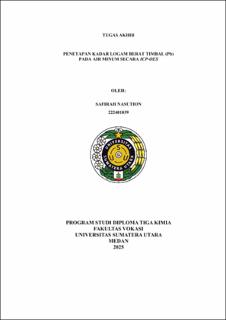| dc.description.abstract | Access to safe drinking water is a fundamental human necessity that must adhere to specific quality standards. One critical chemical parameter to consider in drinking water is the lead (Pb) content. Lead is a heavy metal known for its toxic and carcinogenic properties, posing significant health risks to living organisms. Sources of lead pollution include industrial waste, mining operations, domestic waste, and transportation, in addition to natural occurrences from rocks and soil. Assessing the levels of lead in drinking water is essential to ensure its quality and safety, following the standards established by the Minister of Health Regulation No. 2 of 2023, which stipulates a maximum allowable concentration of 0.01 mg/L. This study employed the ICP-OES (Inductively Coupled Plasma Optical-Emission Spectrometry) method to analyze the presence of lead in drinking water samples. The analysis revealed lead concentrations of 0.001063 mg/L in test sample Number 80, 0.000303 mg/L in test sample Number 81, and 0.009786 mg/L in test sample Number 82. The lead levels in these test samples were found to comply with the requirements outlined in Minister of Health Regulation No. 2 of 2023, adhering to the established threshold of 0.01 mg/L. | en_US |


